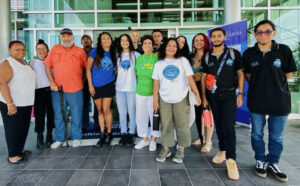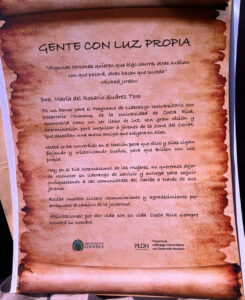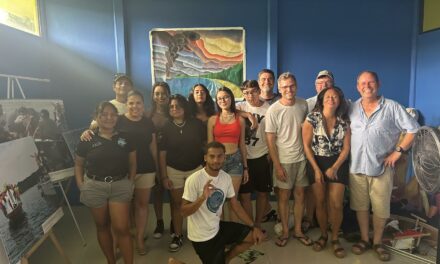We are not Historians, but today We are Making History
Speech by María Suárez Toro,
Embajadoras/es del Mar
presenting the awardee youth divers
to the University of Costa Rica,
March 8, 2024
The treasures that these youth have found:
The uncovered treasure lying in the bottom of the ocean in Punta Cahuita in the Cahuita National Park by our community youth is three fold.

First, it has been a door – an amazing door – opened by the youth’s cultural and scientific stewardship – to our remote past, into a “yellow brick road” filled with connections to our origins in Africa, slave and merchant trade, navigation, colonization, mutiny in resistance to slavery, indigenous resistance to colonization, pirates in their favorite hiding place in Costa Rica’s Caribbean, fishermen and their families that came later and today, a youth’s quest that has organized locally to claim their legacies by combining their ancestral knowledge with the methods of archaeology in a citizenship science with which they have been able to make history without being historians.
It is the story of the identity of two sunken ships – the Fredericus IV and the Christianus V – two Danish slave ships that arrived here by mistake on their way to the Caribbean island of St. Thomas with 650 African men, women and children to be enslaved.
Here, in what is today the Cahuita National Park, the sailors and African mutinied when the captains refused to stop for water and food. Angry, hungry and forced to have left their land, they crafted a resistance: the Africans were released in the shoreline and a nearby fishing barge was hired by the sailors to take them to nearby port of Portobelo in Panama, burning the Fredericus IV and the Christianus V left to crash against the reef.
The destiny of most of the over 600 of the Africans is unknown. We know from colonial records, that 105 of them were recaptured in Matina and enslaved again. Their traces are in historical archives in Costa Rica, Denmark, Spain and Guatemala.
We know that 22 of them were taken to the barge by the captains as their property and that but upon arrival in Portobello but were released by local Spaniard authorities after a trial against the captains.
We know that some some were taken prisoner by Miskito indigenous warriors that tried to take them to the English Protectorate in the Atlantic Coast of Nicaragua.
The rest, the majority of them, must have fled to the highlands of Talamanca where they disappeared from history once again. They must have met the Bribri and Cabecar. It was 1710, the height of the resistance headed by Pabru Presbere to resist Spanish colonization. If these Africans recovered their freedom it is because they joined them in their struggle to keep theirs.
Their traces were, once again, lost to the history, but are ever present in the DNA of the mixed population. It is thus, in the culture such as the arts, language, food, agricultural ways of producing, ancestral ways of producing knowledge, and their ways of organizing for life and lifelyhood in harmony with the territory all living beings.
Because this community cultural underwater project is in the hands of Afro, Bribri, Cabécar and mixed local youth, it is the hidden history of the “disenfranchized” in a world where history has been written by the conquerors. The “winners”, that not only conquered the land, but in doing so, erased from history the traces of the stories of the “others” and, in silencing, discriminating and devaluing them, disconnected them from their own story and origins.
When the descendants of “those others” in official history, have become the ones to steward community underwater archaeology, history becomes the uncovered narrative of those whose stories are disappeared from the history books. Disappeared in the national imaginary. Disappeared from the official story, but ever so present in the witnesses that are the artifacts in the bottom of the ocean in a place where everything came from the sea, like the coastal Caribbean.
Then they have become ever more visible and present in the arts, cultures and livelihoods of the population and their territories in Talamanca and elsewhere; ever present in the memory of the waters that birthed the life of the planet and continues regenerating life and bringing back the memories lost.
Second, it has also uncovered myths and mythologies – that codified knowledge that lies present, but sometimes dormant, in the memory that the Afro and Bribiri population carry with them and claim to see in dark night in Punta Cahuita and elsewhere.
That light which Ambassadors of the Sea have given the name Tona Ina in Yourba, la Luz Marina in Spanish, Sea Light in Creole and English, and Deje Boe in Bribri and Cabécar is the memory of the waters.
By creating a literary ancestral, matriarchal character to tell the saga of these youth’s community endeavor, Ambassadors of the Sea is also contributing to an unknown global discipline of archaeology – archaeomythology – created by Dr. Marija Gimbutas. The Luthuanian-USA American archaeologist and anthropologist, in her research the ruins of what she named “Old Europe” during the Neolithic, believed that in order to understand the societies that created them, a multidisciplinary approach is necessary.
For Ambassadors of the Sea, archaeomythology and our citizenship science in underwater archaeology is the science of recovery the WHOLENESS of what we have been and can re-claim, when the study of the vestiges of past times (archaeology) are in the hands those who have not been in history, they find their ancestral roots in pre-history, in the codified knowledge expressed in their myths and artistic expressions of yesterday, today and forever, once recorded in today’s historical record.
Felicidades to the young generation of Afro and Bribri divers and their communities, you are re-conceptulizing the “pura vida”.
_____
The youth who received the award are:
Maraya Jiménez Taysigue, Pete Stephens Rodríguez, Aarón Mora Streber, Adir Garrido Morales, Kevin Rodríguez Brown, Matthew Benetton and Salim Vasquez, all Ambassadors of the Sea in Cahuit.
 As co founder, I received an unexpected award on International women’s Day, which I graciously received
As co founder, I received an unexpected award on International women’s Day, which I graciously received
“in the name of the Southern Caribbean communities who for the last 200 years have been the ones who protect their treasure: its nature, its ancestral culture and territory and as a maternal species, have cared for a new generation that provide continuity to such history”.
Other 26 Ambassadors of the Sea scuba divers will receive certificates in the mail for their contribution to the Expeditions between 2016-2023 that led to the finding of such “treasures” in the Caribbean:
- Royer Coloner Leiva (Expediciones 2016, 2017 y 2018)
- Tygo Constant Brederoo (Expediciones 2016 y 2017)
- Esteban Gallo Madrigal (Expediciones 2016, 2017 y 2018)
- Anderson Rodríguez Brown (Expediciones 2016)
- Kevin Rodríguez Brown (Expediciones 2016, 2017, 2018 y 2023)
- Pete Stephens Rodríguez (Expediciones 2016, 2017, 2018 y 2023)
- Julio Ugalde Jiménez (Expedición 2016 y 2017)
- Alexandre Koblensky (Expedición 2016)
- Gloriana Brenes González (Expedición 2017)
- Sigrid Lahmann (Expedición 2016)
- Antonio Mora Streber (Expedición 2017, 2018)
- Sangye Wang Brenes (Expedición 2017, 2018)
- Salvador Van Dyke (Expedición 2017, 2018)
- Carlos Mairena Cruz (Expedición 2017 , 2018)
- Armando Molina Mesén (Expedición 2018)
- Arturo Hernández Ruiz (Expedición 2019)
- Kalil Morales Salazar (Expedición fotogrametría 2019)
- Aaron Mora Streber (Expedición fotogrametría 2019)
- Ana María Arenas Moreno (Expedición 2023)
- Jorge Adir Garrido Morales (Expedición 2023)
- Salim Vásquez Rodríguez (Expedición 2023)
- Maraya Jiménez Taysigue (Expedición 2023)
- Giovanni Sandoval (Expedición 2017)
- Facundo Viachica (Expedición 2016)
- Fredrick Wright (Expedición 2016)
- María Suárez Toro (Expediciones 2016, 2017, 2018, 2019, 2023)



Cuca
Te felicito por todos tus logros!
Vivian Vélez
Thank you, Maria, for this absolutely excellent report on the well-earned recognition and awards given to the young scuba divers of Ambassadors of the Sea. It is fitting that you included mention of the “unexpected award” given to you for your dedicated role as co-founder of the Ambassadors and for your inspired guidance of these youngsters as they matured into those who were honored in this ceremony at the University of Costa Rica. Instead of receiving this award for yourself, it is moving to see that you’ve received it “in the name of the Southern Caribbean communities who for the last 200 years have been the ones who protect their treasure: its nature, its ancestral culture and territory and as a maternal species, have cared for a new generation that provide continuity to such history”
Thank you for articulating this important history, preserved in the bottom of the sea, carrying ancestral memories of great significance that will no longer be forgotten.
Thanks…